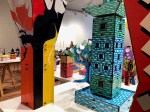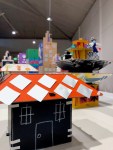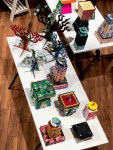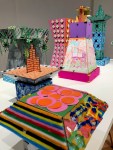Category: Futurama 2.0
Looking back to the future: Futurama 2.0

Tracey Clement, ‘Futurama 2.0’ (instal detail), 26 October 2019 – 29 February 2020 at Fairfield City Museum and Gallery(FCMG).
Looking back to the future
by Tracey Clement
(A shorter version of this essay was published in October 2019 by FCMG in the exhibition catalogue)
Visitors to the Futurama exhibition at the 1939-1940 World’s Fair in New York left with a souvenir badge that declared, “I have seen the future.” What they had actually seen was an elaborate piece of propaganda; a massive model landscape in which modern metropolises were joined by what their creator Norman Bel Geddes liked to call “magic motorways,” all teeming with cars.(1)
The “Word of Tomorrow” presented in Futurama ranged from life-sized to miniature. It featured more than 500,000 buildings, one million trees, and 50,000 cars, trucks and buses (10,000 of which actually moved).(2) Automobiles, and the roads they zoomed along, were very much the stars of the show. Which comes as no real surprise since the primary purpose of this ambitious display was to sell cars and lobby US government officials to build more roads.(3)
Futurama was a giant advertisement for American automotive giant General Motors. And in many ways the more than five million people who visited had seen the future: a rather bleak future in which personal freedom was conflated with owning a car; a future in which whole neighbourhoods were razed to rubble to accommodate roads; a future of pollution, congestion, the rapacious consumption of fossil fuels and the wars waged to secure their supply; a future of anthropogenic climate change.
The future we are living in now.
I have seen the future
I first felt like I had seen the future when I read JG Ballard’s 1962 novel, The Drowned World. Reading this slim sci-fi story in the mid 1980s, when nuclear Armageddon loomed large, Ballard’s post-apocalyptic vision of a ruined semi-submerged metropolis – strangled by vines, patrolled by carnivorous reptiles and equally dangerous men – seemed both realistic and inevitable. Today The Drowned World reads like a prescient vision of our current climate emergency.
Since 2014 I have been using imagery of the ruined model city in sculptures which seek to draw attention to the dangers of an anthropocentric world view. As these mini cities disintegrate they can be read as warnings; a vision of the post-apocalyptic future we are wilfully creating through both action and inaction. But they, like The Drowned World, can also be seen as a glimmer of hope.
As I have argued elsewhere, Ballard’s post-apocalyptic story can be read as a utopian vision of the slate wiped clean. He pictures a fecund world in which humanity is on the wane while the rest of the natural world flourishes without us. It’s a vision of hope, but one tinged with a deep sense of loss: the loss of humanity in all our terrible brilliance.(4)

Tracey Clement, ‘Futurama 2.0’ (instal detail), 26 October 2019 – 29 February 2020 at Fairfield City Museum and Gallery (FCMG).
Futurama 2.0
A few years ago I heard an author say on the radio that the role of a sci-fi writer should be, not to describe impending disaster, but to imagine a positive future; to envisage utopia, to dare to hope. I can’t remember his name, and I’ve paraphrased him wildly, but it’s a valid point.
Today, as our political leaders put their heads in the metaphorical sand and refuse to address the realties of the climate crisis; as temperatures rise along with sea levels; as so many people suffer from despair in the face of ecological upheaval that Australian philosopher Glen Albrecht came up with a name for the condition – solastalgia, which, perhaps unsurprisingly, didn’t really catch on but eco-anxiety did; as we build yet more roads; as we continue to burn coal: catastrophe seems inexorable. Inevitable. Picturing it is just a little bit too much like stating the obvious.
Imagining a better world is much, much harder.

Tracey Clement, ‘Futurama 2.0’ (instal detail), 26 October 2019 – 29 February 2020 at Fairfield City Museum and Gallery (FCMG).
With Futurama 2.0 I’ve tried to rise to this challenge. It is a utopian vision of the city, albeit a modest and subtle one. Compared to its predecessor this model city is utterly lacking in sophistication. There are no bells, no whistles, no moving parts. Brightly coloured and literally held together with sticky tape, it looks like something kids might make.
There are clues to its utopian leanings scattered throughout Futurama 2.0, but this right here is key: children aged four to 12 years-old did contribute to the project, and so did local high school students, and adults from both the Fairfield and broader Sydney communities. More than 50 people answered my call to come make their mark on this model metropolis. We made the city together.
There are other elements in this artwork that point to its utopian leanings. For a start there aren’t any cars at all; Futurama 2.0 is a walk-able city, with (presumably) an efficient public transport system tucked neatly underground. And the trees are massive, old growth giants venerated for their carbon sequestering, shade-throwing and inherent wisdom. Corporate branding is subverted and re-purposed to suit other agendas. Futurama 2.0 is a conglomeration of classic Western skyscrapers, Aztec-esque pyramids, Middle Eastern style towers, pan-Asian pagodas and suburban bungalows all coexisting harmoniously; a kind of multicultural architecture made from just six basic shapes. But the collective nature of its construction remains its most potent symbol of hope.
For it is together that we have the power to shape the future.
Tracey Clement 2019
Notes
- Norman, Bel Geddes, Magic Motorways. New York: Random House, 1940.
- The theme of the fair was “Building the World of Tomorrow. Donald Albrecht, ed. Noman Bel Geddes Designs America, New York: Abrams, 2012, 290-294.
- It was very successful. See: Nathaniel Robert Walker, “American Crossroads: General Motors’ Midcentury Campaign to Promote Modernist Urban Design in Hometown USA,” Buildings & Landscapes: Journal of the Vernacular Architecture Forum 23, no. 2 (Fall 2016): 89-115.
- Tracey Clement, “Mapping the Drowned World.” University of Sydney, 2017, 190. http://hdl.handle.net/2123/17344
 Tracey Clement: Futurama 2.0
Tracey Clement: Futurama 2.0
Fairfield City Museum and Gallery (FCMG)
26 October – 29 February 2020
Futurama 2.0 (work in progress)

Tracey Clement and collaborators, ‘Futurama 2.0’ (detail), 2019, recycled laser-cut cardboard and mixed media, installation size varies, tallest building approx. 65cm. Photo: Rebecca Shanahan. Invite design: Ashely Murray.
Futurama 2.0 is a utopian vision in which everyone has a chance to shape where we live.
Created while I was artist in residence at Fairfield City Museum and Gallery, this mini model city was made with the help of local high school students and kids aged 4-12, and adults from both the Fairfield and broader Sydney communities.
All together more than 50 people answered my call to come make their mark on the city.
We made Futurama 2.0 together.
Tracey Clement: Futurama 2.0
Fairfield City Museum and Gallery (FCMAG)
26 October – 29 February 2020
Opening: Saturday 26 October 2019 from 2pm













